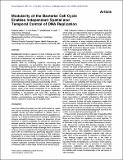Modularity of the Bacterial Cell Cycle Enables Independent Spatial and Temporal Control of DNA Replication
Author(s)
Jonas, Kristina; Chen, Y. Erin; Chen, Y. Erin; Laub, Michael T.; Laub, Michael T
DownloadLaub_Modularity of the.pdf (914.6Kb)
PUBLISHER_POLICY
Publisher Policy
Article is made available in accordance with the publisher's policy and may be subject to US copyright law. Please refer to the publisher's site for terms of use.
Terms of use
Metadata
Show full item recordAbstract
Background:
Complex regulatory circuits in biology are often built of simpler subcircuits or modules. In most cases, the functional consequences and evolutionary origins of modularity remain poorly defined.
Results:
Here, by combining single-cell microscopy with genetic approaches, we demonstrate that two separable modules independently govern the temporal and spatial control of DNA replication in the asymmetrically dividing bacterium Caulobacter crescentus. DNA replication control involves DnaA, which promotes initiation, and CtrA, which silences initiation. We show that oscillations in DnaA activity dictate the periodicity of replication while CtrA governs the asymmetric replicative fates of daughter cells. Importantly, we demonstrate that DnaA activity oscillates independently of CtrA.
Conclusions:
The genetic separability of spatial and temporal control modules in Caulobacter reflects their evolutionary history. DnaA is the central component of an ancient and phylogenetically widespread circuit that governs replication periodicity in Caulobacter and most other bacteria. By contrast, CtrA, which is found only in the asymmetrically dividing α-proteobacteria, was integrated later in evolution to enforce replicative asymmetry on daughter cells.
Date issued
2011-06Department
Massachusetts Institute of Technology. Department of BiologyJournal
Current Biology
Publisher
Elsevier
Citation
Jonas, Kristina, Y. Erin Chen, and Michael T. Laub. “Modularity of the Bacterial Cell Cycle Enables Independent Spatial and Temporal Control of DNA Replication.” Current Biology 21, no. 13 (July 2011): 1092-1101. Copyright © 2011 Elsevier Ltd.
Version: Final published version
ISSN
09609822
1879-0445